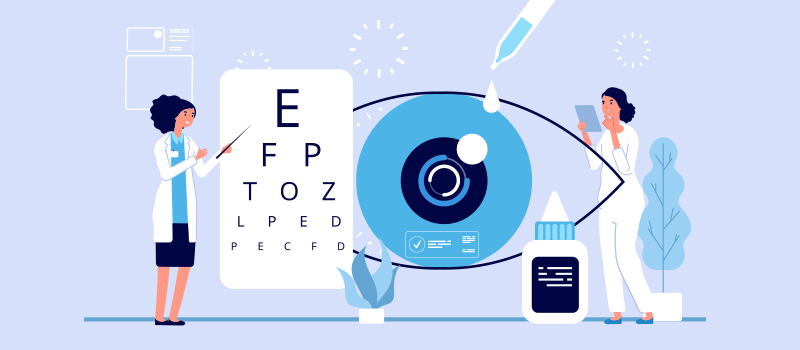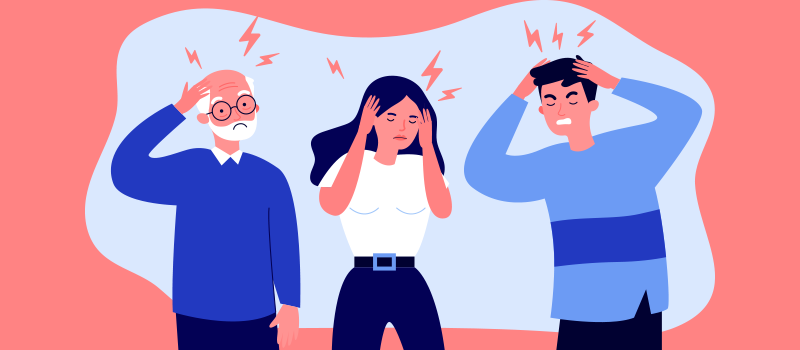What’s the Buzz
The Bee Healthy Blog
What Is a Retinal Migraine Common? Triggers & Symptoms

A retinal migraine is a rare form of migraine that causes visual symptoms in one eye. Although retinal migraine is not a life-threatening condition, it can create a serious long-term adverse impact on the patient’s life, triggering anxiety over repeated attacks.
Continue reading to learn more about the symptoms, causes, and treatment options for retinal migraine attacks.
What is a retinal migraine?
Retinal migraine is a rare condition affecting the eye. This condition is characterized by brief episodes of blindness in one eye and other visual problems, such as flashing lights, twinkling lights, or temporary partial vision loss.
Retinal migraine is sometimes referred to as ocular migraine due to the symptoms affecting the eye and vision.
Although the episodes of retinal migraine are usually short-lived, the symptoms can be frightening and trigger fear and anxiety. If not managed properly, retinal migraine can severely affect the quality of life of the patient by causing frequent episodes of temporary blindness or a visual disturbance.
What happens during retinal migraines?
An episode of retinal migraine starts with visual symptoms affecting one eye. The common warning signs include:
-
Scintillations (visions of twinkling lights)
-
Temporary blindness
-
Scotoma (blind spot or visual disturbance)
These visual symptoms typically last between 5 and 50 minutes. In some cases, the eye symptoms can become worse over time, leading to a regular migraine with a severe headache. In most cases, the headache resolves gradually. A headache can occur one or more hours after the visual symptoms develop.
What are the causes of migraine with aura?
Retinal migraine occurs due to the sudden narrowing or constriction of the arteries in the eye, causing reduced blood flow to the ocular tissues.
Common triggers of a migraine episode include:
-
Emotional stress
-
Smoking
-
High blood pressure
-
Bending over
-
Hormonal birth control pills
-
Dehydration
-
Low blood sugar
-
Strenuous physical activities
-
Intense workout session
-
High altitude
-
Exposure to excessive heat
As the affected eye’s arteries and blood vessels relax, the regular blood flow resumes, allowing the vision problems to subside, along with the other symptoms associated with ocular migraines.
A retinal migraine usually does not cause any abnormalities in the eye. Also, permanent vision loss due to this condition is rare.
What are the risk factors for retinal migraine with aura?
A retinal migraine attack is most commonly found in:
-
People below 40 years of age
-
Women
-
Patients with a personal or family history of migraine and headaches
-
Patients with a pre-existing condition, such as central retinal artery occlusion, branch retinal artery occlusion, lupus, atherosclerosis, sickle cell anemia, epilepsy, antiphospholipid syndrome, and giant cell arteritis
What are the symptoms of a retinal migraine?
Some common symptoms of this condition include monocular visual symptoms (symptoms in only one eye) such as total or partial loss of vision in one eye, usually lasting about 10 to 20 minutes before the eyesight gradually returns to normal, and migraine headaches before, during, or after the visual changes.
In most cases, transient vision loss does not last longer than one hour. Also, in almost all cases, the same eye is affected in each episode.
The eyesight may become blurred or dimmed over a period of time. Some patients also experience scotomas, which are flashes of light or a mosaic-like pattern of dark spots that gradually enlarge, causing a complete loss of vision.
If you experience a sudden loss of vision without a history of any pre-existing eye diseases, seek immediate medical help at the nearest emergency department.
Diagnosis of a retinal migraine
There are no tests that can confirm the diagnosis of migraine headache. Your eye doctor will make a possible diagnosis of retinal migraine after clinical observations that rule out other potential conditions like an eye disease.
Your doctor will also review your symptoms, the characteristics of the visual disturbances, and your personal and family medical history during the assessment to arrive at the diagnosis. You may also be asked to undergo additional tests to rule out other potential medical issues, such as a stroke. A stroke can cause decreased blood flow to your eye, causing temporary vision loss.
Age is another factor that can point to the possible diagnosis of migraine headache. When a person under the age of 50 years old experiences migraine headaches and temporary visual disturbances, it is likely to be due to a retinal migraine attack. This is especially true when there is no history of vascular diseases such as high blood pressure, stroke, or high cholesterol.
Treatment for retinal migraine
There are no clear guidelines to treat retinal migraine attacks. Once vision loss and other symptoms start, the episode runs its course.
Retinal migraine treatment usually involves taking pain-relieving medications for headaches and reducing exposure to potential triggers. Identifying the triggers for retinal migraine can be difficult. Therefore, doctors may recommend keeping a headache journal to keep track of your daily activities, stress levels, and diet.
Your doctor might also prescribe preventative medication to reduce the frequency of migraine attacks.
The treatment plan usually involves a trial-and-error approach because there is no one best way to treat retinal migraine in all patients. Your doctor might have to try one or a combination of different medications to find the treatment that works best for you.
Foods can be a main trigger for ocular migraines, and keeping a list of potential dietary triggers in your headache journal can help you avoid those foods in the future.
Preventive therapies may be recommended for the management of the underlying cause. For example, calcium channel blockers may be prescribed for controlling blood pressure; antiepileptic drugs may be prescribed if the attacks are associated with epilepsy; or antidepressant medications may be given if the episodes are associated with stress and anxiety.
Similarly, treatment with low-dose aspirin can be helpful in patients who have a vascular disease.
It is important to note that triptans and ergotamines are not used to treat retinal migraines, as these drugs can worsen vision loss. Your healthcare professional may also advise you to stop using birth control pills and quit smoking to improve the prognosis and prevent future episodes of retinal migraines.
What are the possible complications of retinal migraines?
Retinal migraines can increase the risk of conditions associated with reduced blood flow to the tissues of the eyes, causing visual disturbances.
For example, it may cause retinal hemorrhages, which is damage to the retina that causes a break or bleeding at the back of the eye. Hence, your eyesight needs to be regularly monitored to assess the impact of retinal migraines on your eyes. Regular follow-up appointments with your eye specialist can ensure the damage to the retina and blood vessels is detected at an early stage, allowing you to receive timely medical interventions.
Retinal Migraines: Frequently Asked Questions
Is retinal migraine the same as ocular migraine?
These two terms are often used interchangeably, although there are a few important differences.
An ocular migraine is more common and typically occurs in both eyes, while a retinal migraine is very rare and tends to affect just one eye when the blood vessels supplying the blood to the eye become narrow.
What triggers an ocular migraine?
Factors such as stress, side effects of birth control pills, and exposure to excessive heat can trigger an episode of ocular migraine.
When should I be worried about a retinal migraine headache?
You should be worried about a retinal migraine if the vision loss persists for longer than one hour or if you experience more frequent repeated attacks.
How frequently do retinal migraine attacks come?
Most patients experience an episode of retinal migraine with aura once every few months, although the frequency varies widely among different patients.
Is a retinal migraine the same as a migraine with a visual aura?
People often mistake the episodes of retinal migraine for visual aura. The visual disturbances occurring in migraine with visual aura occur in both eyes because they arise from the brain.
The symptoms of retinal migraine affect only one eye as the episodes occur due to the reduced blood supply to one eye. This is one of the characteristic features of retinal migraine that differentiates it from other forms of headaches or migraines.
Hence, retinal migraine should not be confused with migraine with visual aura or headache-type migraine that usually affects the vision of both eyes.
Is ocular migraine a mini-stroke?
Ocular migraine and stroke are different conditions. Having an attack of ocular migraine does not mean you are having a mini-stroke. However, patients with ocular migraines do have an increased risk of stroke.
How to check if my visual symptoms are due to retinal migraine?
Some characteristics of retinal migraine include the following:
-
It usually affects only one eye.
-
The attacks often come on abruptly.
-
Vision problems usually last around 10 to 20 minutes but may sometimes last up to an hour.
-
You might experience a blind spot in your visual field.
-
You may experience moderate to severe headaches or migraine aura at the time the eye symptoms occur or shortly afterward.
-
You may experience other eye symptoms, such as blurring of vision or seeing zigzag patterns, flashing lights, and colored lines or spots.
-
You might have only eye symptoms without a headache.
What steps should I take when I experience retinal migraine headache?
-
Try lying down or sleeping in a dark room until the episode subsides.
-
Increasing your intake of water to avoid dehydration.
-
Having a healthy and nutritious diet.
-
Avoiding dietary triggers.
-
Eating meals at regular times.
-
Getting adequate sleep and rest.
-
Maintaining a healthy weight.
-
Managing stress.
-
Avoiding things that can trigger migraines, such as caffeine, smoking, and alcohol.
References:












SOCIAL